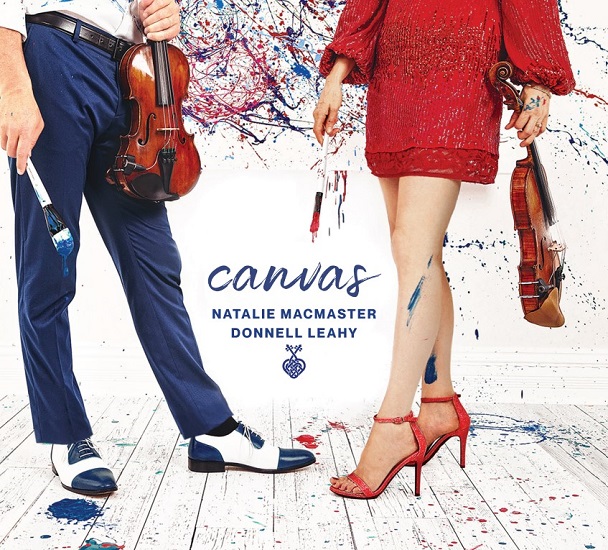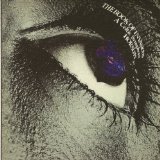
And still the pandemic albums keep coming; it took a while to adjust, but the adversity of 2020 and 2021 was a genuine mother of invention. The response of Natalie MacMaster and Donnell Leahy was to take the opportunity to go back to basics and start all over again with a tabula rasa, or a blank canvas, fusing their traditional musical roots with a huge variety of influences from across the globe and across the ages. All the way from Scotland in the nineteenth century to Spain and Latin America in the 2020s; that’s a broad and sometimes weird canvas.
The title track and exposition is a very short piece priming the canvas for the rest of the album. It’s a sketch that introduces atmospheric banjo and fiddle with some ethereal backing vocals and a bit of synth bass, hinting at some of the interesting combinations yet to come. And they are very interesting combinations.
Of the album’s thirteen pieces, two have lyrics (‘Woman of the House’ is sung by Rhiannon Giddens in Gaelic while ‘Wish You Were Near’ is sung by its author, Robyn Cunningham), three have backing vocals and the remaining eight are instrumentals ranging from the plaintive traditional James Scott Skinner tune ‘The Laird o’ Bemersyde’ to some absolutely bonkers (in the best possible way) fusions with other musical traditions. If you’re not admiring the quality of the musicianship, you’ll be smiling at the audacity of some of the fusion arrangements. The other James Scott Skinner to appear on the album, ‘The East Neuk of Fife’ begins its journey as a traditional fiddle piece before Natalie’s variations on the theme take over and the slap bass kicks in. That was definitely one of the smiley moments.
Here are some of my personal highlights. ‘So You Love’, featuring classical cellist Yo Yo Ma which starts with a solo piano, builds through a combination of Gaelic and Eastern European styles, string ensembles and a cello solo before speeding up into a huge string section with counterpoint fiddles and releasing the tension with a slow finish; it’s a symphony in miniature. ‘The Case of the Mysterious Squabbyquash’ is another kitchen sink production that gives a nod to the great Irish folk-rock fusion band, Horslips. The song opens with fairly traditional fiddle stylings and builds with rock bass and drums before a Hammond break leads into an outrageously over-the-top wah-wah guitar solo from the album’s producer Elmer Ferrer that sums up the album; you really don’t know what’s coming next. It could be step dancing, a horn section counterpoint fiddles.
‘Canvas’ is a truly remarkable piece of work. Just when you think Natalie and Donnell have exhausted the creative possibilities and they pull another trick out of the bag. You won’t get tired of listening to ‘Canvas’ any time soon and I think you’ll be grinning every time you listen to it.
‘Canvas’ is released in the UK on Friday April 7th.
Here’s the official video for ‘Colour Theory’ featuring Brian Finnegan:
 I’ve always been fascinated by the way a love of music can link episodes in your life, even when they have nothing else in common. When you meet someone and discover that you were at the same incredible gig years before or that you both love an obscure country, soul, blues or rock artist that no-one else has heard of. Or when you’re managing a venue and your entertainments manager tells you that he’s booked an artist for a St Patrick’s Day gig called Johnny Fean and you realise that it’s the Johnny Fean who played with Horslips twenty years earlier. Then, another fifteen years later you post something on a social network and the same Johnny Fean “likes” it. That’s the kind of link I mean and I want to tell you about the band and the album that triggered these coincidences.
I’ve always been fascinated by the way a love of music can link episodes in your life, even when they have nothing else in common. When you meet someone and discover that you were at the same incredible gig years before or that you both love an obscure country, soul, blues or rock artist that no-one else has heard of. Or when you’re managing a venue and your entertainments manager tells you that he’s booked an artist for a St Patrick’s Day gig called Johnny Fean and you realise that it’s the Johnny Fean who played with Horslips twenty years earlier. Then, another fifteen years later you post something on a social network and the same Johnny Fean “likes” it. That’s the kind of link I mean and I want to tell you about the band and the album that triggered these coincidences.
Horslips had released five albums before “The Book of Invasions – A Celtic Symphony” was released in April 1976. This was the first album the band recorded for Elton John’s label, DJM, and despite heavy promotion (including coloured vinyl singles) and good reviews, it only achieved an album chart position of 39 for one week in the UK. One of the reasons it’s so memorable for me is that it was part of the soundtrack for my “A” level revision through the long hot summer of 1976 (alongside Gallagher and Lyle’s “Breakaway”, Thin Lizzy’s “Jailbreak” and the Joe Walsh live album “You Can’t Argue with a Sick Mind”).
So, what makes the Horslips album a Closet Classic? The band had experimented with various permutations of rock, Irish folk and Celtic mythology on their previous albums, but it was on “The Book of Invasions” that everything gelled with the long-cherished idea of creating a classical symphony from these components. Just to wrap some context around “Invasions”, this was the era of the concept album when virtually every artist or band was trying to create a theme to link a few dodgy songs (yes, I do mean you Rick Wakeman) to create a pseudo-classical work.
Is it a symphony? Well, it’s split into three movements and it has a leitmotif which crops up throughout the album in various guises. “Daybreak” opens the album with the “Tá ‘na lá” (“It is day”) theme from a traditional Irish drinking song, in one of its many appearances, as a trumpet major key triad followed by a guitar harmonic version which leads into a harmony guitar version. before modulating into a more menacing minor key. And that’s just the first track. I’m not going to list all of the folk tunes used on the album because you can find them for yourself on the Horslips website; I’ll just say that it’s quite common on this album for a song to morph from a traditional ballad into a classic 70s riff-driven rock song.
If you’re looking for classic Celtic rock songs, then you’ll find plenty of those on this album. “Trouble (With a Capital T)”, “The Power and the Glory” and particularly “The Warm Sweet Breath of Love” (a dead ringer for the under-rated Thin Lizzy song “Running Back”) would all sound perfectly at home on “Jailbreak” which was released in the same month. But it’s not just the rock songs which work on “Invasions”; the folkier “The Rocks Remain”, “King of Morning, Queen of Day” and “Sideways to the Sun” (the story of the downfall of the Tuatha De Danann) and the instrumental interludes are all beautifully played.
I’m not saying “The Book of Invasions” is a perfect album, but it does have its perfect moments (the segue from “The Power and the Glory” to “The Rocks Remain”, for example), and at a time when everything can be found online, it would be a shame to miss this one. The scope of the album is quite breathtaking; Irish mythology rubs up against folk melodies, rock arrangements, symphonic themes, a huge range of instruments and bags of style to create a genuine classic album.
This album was the chart highpoint for Horslips in the UK and, although the subsequent “Aliens” and “The Man who Built America” were popular in the USA, the band split in 1980. Like many bands from this era, Horslips reformed for selected gigs in the noughties and can still be seen live occasionally. If you’re into rock or folk or both and you haven’t heard this before, you really should give it a listen especially after I’ve made it so easy for you.


